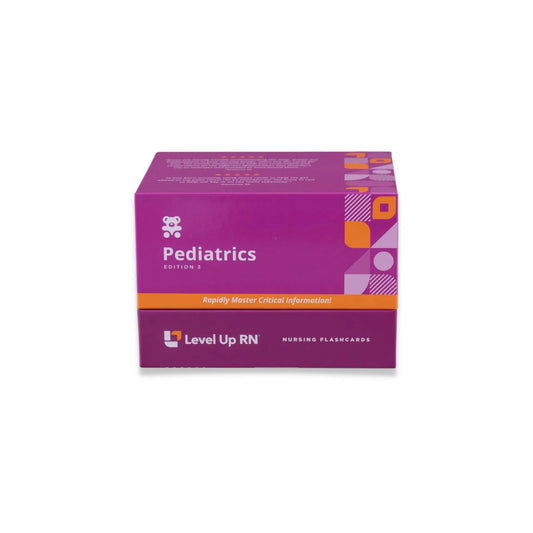Peds, part 16: Respiratory Disorders - Epiglottitis, Croup, Bronchiolitis
Updated: Cathy ParkesEpiglottis, acute laryngotracheobronchitis (croup), and bronchiolitis (RSV). The pathophysiology, signs/symptoms, diagnosis, treatment, nursing care, and patient teaching associated with these disorders.
Full Transcript: Peds, part 16: Respiratory Disorders - Epiglottitis, Croup, Bronchiolitis
Full Transcript: Peds, part 16: Respiratory Disorders - Epiglottitis, Croup, Bronchiolitis
I am Cathy, with Level UP RN. In this video, I'm going to continue my coverage of pediatric respiratory disorders. Specifically, I'll be talking about epiglottitis, croup as well as bronchiolitis. So if you have our Level UP RN pediatric nursing flashcards, definitely pull those out and definitely pay close attention to the bold red text on these cards. There's going to be many important points that you will need to know about these disorders. At the end of this video, I'm going to give you guys a little quiz to test your knowledge of some of the key points I'll be covering in this video. So definitely stay tuned for that.
First up, let's talk about epiglottitis, which is the life-threatening inflammation of the epiglottis, which is a flap of cartilage at the top of the larynx that protects the airway when we're eating. So it prevents food from going down into the airway. So the pathophysiology behind this disorder is that a bacterial or viral illness causes edema or swelling of the epiglottis and the surrounding structures, and this can lead to airway compromise. This disorder is more common in younger children between the ages of two and five. It is also more common in children who are not vaccinated. In particular, children who have not had their Hib vaccine are going to be at higher risk for epiglottitis. Signs and symptoms include a high fever, sore throat, a hoarse or muffled voice, drooling, anxiety, dysphasia - so difficulty with swallowing and respiratory distress. If we suspect that a patient has epiglottitis based on their symptoms, we are absolutely not going to obtain a throat culture or use a tongue white in their mouth or put anything else in their mouth, for that matter, because that can result in loss of airway. So treatment of this condition includes securing the airway through intubation and then the administration of antibiotics, as well as corticosteroids to decrease inflammation. In terms of nursing care, we're going to want to do everything we can to keep the patient and the family calm. In addition, we do not want to leave the patient on their back, so in a supine position, because that can make their symptoms worse.
Next, let's talk about croup. So the fancy name for croup is acute laryngotracheobronchitis. So we have inflammation of the larynx, the trachea, and the bronchioles. So this occurs when a viral infection, such as parainfluenza, causes inflammation of the lower respiratory structures. And this, in turn, causes dyspnea or difficulty breathing. The hallmark symptom of this disorder is a barking cough. It can also cause inspiratory stridor, which is a high-pitched sound that occurs when we have narrowing of the airways. It can also cause tachypnea near and signs and symptoms of respiratory distress. In terms of diagnosis, when a child comes with that barking cough, that is all that is needed to diagnose this condition. Treatment includes nebulized epinephrine corticosteroids, and in severe cases, intubation may be necessary. In terms of family teaching, we want to prevent patient agitation, which can worsen symptoms. We want to make sure the patient stays hydrated, and we want to advise the family to use a cool-mist humidifier in the child's room.
Lastly is talk about bronchiolitis, which is a common viral lung infection in children caused by RSV or respiratory syncytial virus. So this virus is spread through droplets, and it results in inflammation of the bronchioles and an increase in mucus production. Signs and symptoms can include a cough, sneezing, fever, wheezing, deep and rapid breathing, as well as prolonged expiration. In terms of diagnosis, we can collect a nasopharyngeal swab to check for the virus. Treatment is largely supportive. For severe cases, mechanical ventilation may be necessary and antivirals may be used in those severe cases. In terms of nursing care, we're going to want to suction excess secretions, if needed, and then we want to keep the patient calm as well as hydrated, and then oxygen therapy should be provided if ordered by the provider.
All right, it's time for a quiz. I have three questions for you. First question, a hoarse voice, drooling, and fever are indicative of what respiratory disorder? The answer is epiglottitis. Question number two, for a patient with epiglottitis, diagnosis should be confirmed with a throat culture. True or false? The answer is false. We are not going to obtain a throat culture or put anything in the patient's mouth. Question number three, a barking cough and respiratory distress are indicative of what respiratory disorder? If you said croup, you're right, but I would also be familiar with the fancy name for croup, which is acute laryngotracheobronchitis. All right. That's it for this video. Stay tuned for more information on respiratory disorders in the pediatric population. Take care and thank you so much for watching.
A life-threatening inflammation of the epiglottis, which is a flap of cartilage at the top of the larynx that closes over the airways while we're eating to protect the airways from the [inaudible]. So I hope that was a helpful video for you [laughter] where I'm just talking nonsensically.


